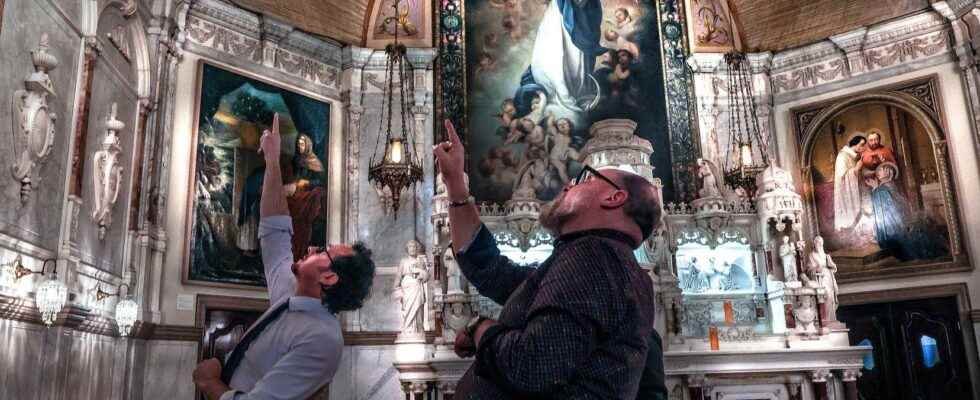The oldest stone chapel in Montreal has been combed through… by a 3D camera. Not only does this meticulous digitization work serve to support the restoration work of the Notre-Dame-de-Bon-Secours chapel, but it will eventually allow visitors to visit the site virtually as it appeared at the time, it hundreds of years ago.
The Notre-Dame-de-Bon-Secours chapel, sitting on its 250th anniversary, is gradually revealing its mysteries since experts scanned the exterior and interior of this heritage building located in the heart of Old Montreal. .
“The scan is able to go to places where we are not able to access. We may discover things in the coming years, ”explains Jean-François Royal, general manager of the Marguerite-Bourgeoys historic site, the museum responsible for preserving the work and legacy of this figurehead in history. of the town, including the chapel.
This “scanner”, a device no bigger than a toaster, slips into hard-to-reach places. Its radar scanning makes it possible to reconstruct on a computer in detail and “to the nearest millimeter” the smallest corner of the heritage building, explains Mr. Royal.
“In my dream, I would like schools in remote areas that will never come to visit the museum, like in Amos or Sept-Îles, to be able to have a tour of the archaeological site and the finds that have been made there. [On veut pouvoir réaliser] a visit with a facilitator, but virtually, and see the site with augmented reality glasses. »
This dream is not far from reality. The facade has already been digitized. The entire collection of artifacts from the historic site will follow this month.
In my dream, I would like schools in remote regions that will never come to visit the museum, such as in Amos or Sept-Îles, to be able to have a tour of the archaeological site and the finds that have been made there.
And we guess all the potential of the technology by going down in the basements of the chapel. Hidden here are the ruins of Montreal’s very first church, accidentally burnt down in 1754. Ghosts still roam around the stone foundations revealed by recent archaeological work. The charred church square, the remains of the old lime kiln and Aboriginal traces draw the contours of the founding of Quebec. These ghosts could soon come to life thanks to augmented reality technology.
The site was chosen at the time because of its “particular relief”, tells us Stéphan Martel, historian of the chapel. “We are elevated above the river. […] The rue Notre-Dame, behind, makes a speed bump and protects from the wind. There is not very far a rather high hillside, where a mill had been installed. Next to it, we have a large swamp which allows access to food and abundant resources. »
The setting is thus set for a virtual reconstruction of the first masses in the Montreal of yesteryear.
Not so young technology
It is the company ISCAN 3D, based in Trois-Rivières, which is responsible for safeguarding – at least virtually – this heritage. The first time company president Richard Lapointe got his hands on such a tool was in 1999.
“The first time we scanned an archaeological site 12 meters long by 2.5 meters wide and 1.5 meters deep, it took us eight hours of work, he recalls, smiling in the voice. Today, in eight hours of work, you can go around the convention center outside. »
He and his team of fifteen people have hundreds of similar projects in their history: “the Canadian Center for Architecture, the Oka Abbey, the Roger-Gaudry Pavilion [Université de Montréal]Royal Victoria Hospital, Montreal Convention Center, Notre-Dame Basilica, Quebec City Parliament, National Museum of Fine Arts of Quebec, Grand Theater of Quebec, Habitat 67, Quebec City Halls , Montreal, Sherbrooke…”, lists the one who presents himself as an “archaeologist”.
“Traditionally, this is done with a measuring tape. It’s good, the tape measure, for an office, for a room, but not for a deformed structure that is 300 years old…”
Because the use of these digitizers aims first and foremost at the physical preservation of buildings. No crack, no movement, no twist or deformation of this old building escapes the supernatural eye of the camera. It then becomes possible to recreate very precise architect’s plans, without going through the drawing board.
The 3D reconstruction also makes it possible to erase the vault of the current chapel to reveal “the entire wooden structure which supports the roof”, indicates Jean-François Royal. “It’s absolutely beautiful for wood frame enthusiasts. »
Eventually, it will become possible to return to the past to visit the places in the manner of a “simulation of video games for historical reconstruction”, promises Richard Lapointe. “You can reconstruct 3D artifacts and reposition them in space so people can see the arrowheads, the tools, the ceramics, where they came from and where they were used. […] It’s in the plans for 2023-2024. »
This is a “crazy project”, according to museum officials, the same qualifier they use to talk about Marguerite Bourgeoys’ project when the time came to build her church in the 17th century.e century.
Today, some 275,000 people visit the stone and wood chapel each year… in person. The current sacred place also welcomes the faithful for masses on Sunday. A few dozen homeless people also come here to warm up in very cold weather. Supporting others is still part of the vocation of the place, several centuries after its foundation.
